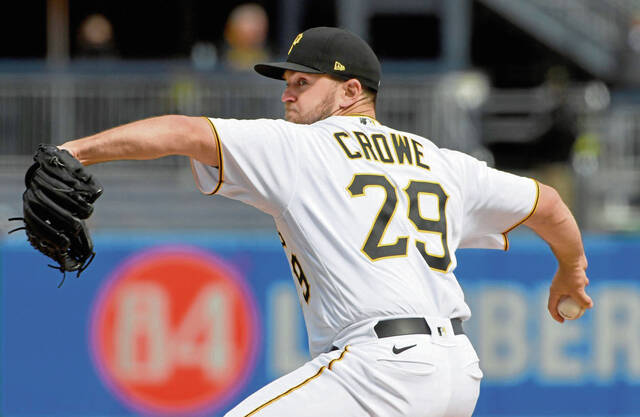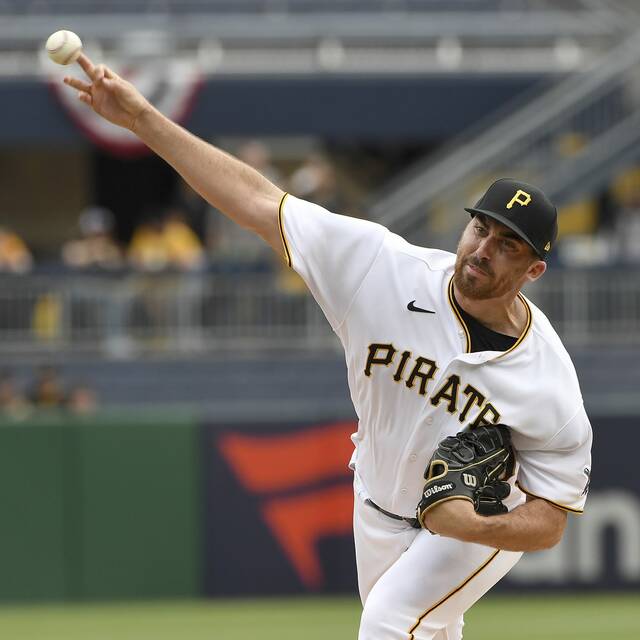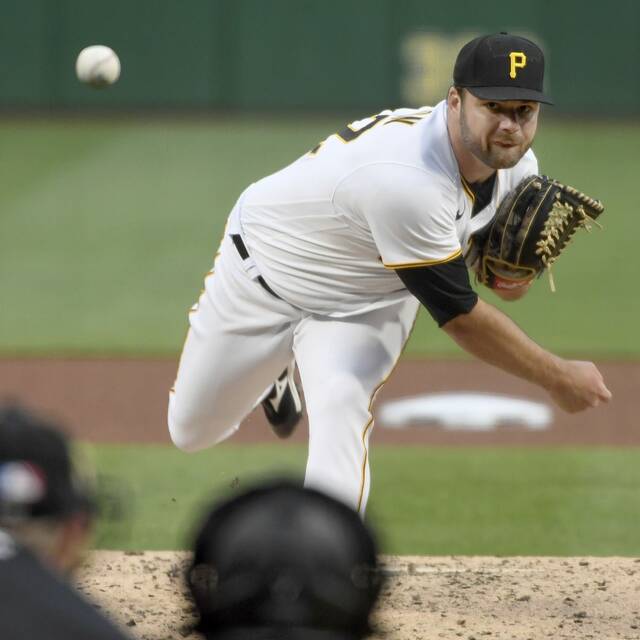Pirates embrace unorthodox with pitching staff, where results are anything but ordinary
The Pittsburgh Pirates have embraced the unorthodox with their pitching staff, a bizarro world where roles are no longer defined in traditional terms and the results are anything but ordinary.
Starters have become relievers, relievers have started, piggybacking has become popular and the closest thing the Pirates have to a closer (David Bednar) often doesn’t pitch in the ninth inning.
If that sounds like Pirates manager Derek Shelton is picking his pitchers while throwing darts blindfolded, it’s quite the opposite. With a rotation that is short on high-end talent but long on depth, the Pirates are attempting to play to their strengths to mask their weaknesses.
The plan is one that is being implemented throughout the Pirates system, general manager Ben Cherington said, as a way to lessen the load on the starting rotation while stretching out some pitchers after a shortened spring training after the 99-day lockout.
If the execution can be complicated, its goal is simple.
“Just trying to get outs as fast as we can,” Cherington said. “That’s the goal, right? If you work back from that, we’re just trying to help individual pitchers get into roles that we think give them the best chance to get outs as fast as they can.
“Sort of not worry about how pitchers were used in the past and more about who we have now, both at the major-league level and in the minor-league level, what’s the role and, more specifically, what’s the spot in the game where they have the best chance as possible to get as many outs as quickly as possible?”
Getting outs is one thing, and victories another. Pirates starting pitchers have yet to earn a win, a 22-game stretch to start the season that eclipsed the 1988 Baltimore Orioles as the longest in major-league history. Where those Orioles started 0-21, the Pirates (9-13) were tied with the Chicago Cubs for third place in the NL Central, 5½ games behind the Milwaukee Brewers, entering Tuesday.
Now that active rosters have been reduced to 26 players — teams are permitted to keep 14 pitchers through the end of the month — the Pirates’ starting pitching plan will face a true test.
No starter has thrown 100 pitches in a game, with JT Brubaker throwing 94 in five innings in a 5-2 loss at the Brewers on April 19. On Sunday, right-hander Mitch Keller became the first starter to go six innings. Instead, the Pirates have turned to starters-turned-relievers such as righty Wil Crowe and lefty Dillon Peters to carry them through the middle innings.
Crowe, who led the Pirates with 25 starts last season, earned his first save April 13 and his first victory in relief April 21, both against the Cubs. Peters, who started in 30 of his 37 games before this season, didn’t allow a hit against the first 21 batters he faced. Peters has tossed 13 1/3 scoreless innings, including two-plus innings as the opener against the Brewers on April 27.
“I’m here to throw the ball and get outs for this team,” Peters said. “I’m not worried about personal stats or what I can put up. I want to catch ‘dubs’ and get this team rolling and put ourselves in great positions.”
While the Pirates have touted Keller as having top-of-the-rotation stuff, Shelton called the 33-year-old lefty Jose Quintana the team’s most efficient pitcher last weekend. Neither one fits the bill as a true No. 1 or 2 starter, though Shelton promised if someone emerges in that role for the Pirates, he will allow them to pitch deeper into games.
“I think most guys will start probably more the way we are right now, then they will prove to us that they can do that,” Shelton said. “And I know the question you’re going to ask on the backside of this: How are they going to prove it if they don’t pitch the sixth or the seventh? Their stuff will prove it. The way we have the ability to track guys’ stuff now, their stuff will prove it to us. You’ll slowly see guys get it.
“Sometimes it will be situational. Sometimes, you may get the extra inning or two because we don’t have the bullpen that we normally have. Maybe we really like those matchups. Or maybe it’s a deficit game. So you give a guy a longer leash. Or maybe it’s a four-run game, so you give a longer leash. There’s so many factors that come into play, but I think probably the best answer for that question is stuff.”
Until they show that stuff, the Pirates are preaching and practicing fluidity, believing the bullpen can provide clarity by focusing less on going through the batting order three times and instead challenging hitters.
As much as decisions are matchup-based, pairing pitchers against certain hitters or situations, the Pirates also are taking the human element into consideration by putting them in positions for success.
It worked wonders for righty Bryse Wilson. After three starts, Wilson went to the bullpen with the directive to attack hitters with his best stuff. He responded by striking out four while allowing one hit and no walks in four scoreless innings in a 3-1 loss to the Brewers on April 27.
“It’s a huge confidence builder,” said Wilson, who called his first two outings “a battle” and had trouble controlling the strike zone in his third start. “So for me, it’s a good step going forward in the confidence area and being able to (think), ‘Hey, I can fill up the zone, and I can go at my hitters with my stuff.’ ”
It worked in reverse for right-hander Chase De Jong, who started nine games last season before undergoing surgery to repair cartilage damage to his left knee. De Jong signed a minor-league deal in spring training, and his contract was selected after he started the first seven innings of a combined no-hitter for Triple-A Indianapolis.
What eased his transition to a multi-inning role in the bullpen, De Jong said, was the open communication from the front office to the minors. As he was building innings, Indianapolis pitching coach Dan Meyer kept De Jong apprised of the Pirates’ plans and sought feedback.
“It was nice that my opinion was valued, and I was essentially cc’d in on the conversation, but knowing that it was something that could be required of me helped me mentally prepare for that,” De Jong said. “I’m still always going to be a multi-inning guy. I know the value I have is length.
“Being a starter, one of the most difficult things is managing your pitch count and essentially your efficiency to manage the lineup sometimes two or three times to not completely tax the bullpen. You’re in more of an attack mode instead of an efficiency mode. It’s fun. I’m going out there trying to manufacture swing and miss and soft contact. Focusing on swing and miss puts me in attack mode more than finesse mode.”
Right-hander Zach Thompson, acquired from the Miami Marlins last fall in the Jacob Stallings trade, has pitched as a starter and a reliever and finds comfort in knowing the Pirates are asking for only three or four innings from their starters early in the season. Thompson believes having the bullpen’s bulldog mentality can carry over to strong starts.
“Usually you have to gameplan for that third time through, knowing what you’ve been throwing to these guys,” Thompson said. “Now you can just treat them as a reliever, go out and beat them with your best stuff as best you can. Shelty’s been talking about just going out there and get outs until we pull you out of the game. It’s nice to go in with an almost reliever mindset that I’m going to go after them for as long as I’m in there.
“You’ve got to have good team chemistry. Everyone has to buy in to what’s going on. We’re all here on the same page, that we’re trying to get outs and do it the best that we can as starters and for the relievers to come in and get outs. As long as we’re all connected and on the same page, stuff will start clicking for us.”
Kevin Gorman is a TribLive reporter covering the Pirates. A Baldwin native and Penn State graduate, he joined the Trib in 1999 and has covered high school sports, Pitt football and basketball and was a sports columnist for 10 years. He can be reached at kgorman@triblive.com.
Remove the ads from your TribLIVE reading experience but still support the journalists who create the content with TribLIVE Ad-Free.




